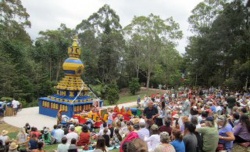Rupaskandha
rupaskandha; aggregate of five senses, the five sensations,rupa skandha and the implicatory communications associated in sense perceptions vijnapti).
Rupaskandha; Form ;(Sanskrit: rupa – Tibetan: gzugs)
Rupa Skandha of Form means, that contact (Sanskrit: sparsa) occurs between sensual faculty (Sanskrit: indriya, literally meaning capacity or power) and sense object, whereby the sensual faculty is being disturbed and activated.
This is how actual sensation happens. In the Dharma, sensual faculty rather than the sense organ is described, because this is, what is being experienced, when someone meditating investigates, how sensation takes place in their own mind.
There are 6 sensual faculties, corresponding to 6 kinds of sense objects and 6 kinds of sense-consciousness (read the column to the right). The 6th sense-consciousness is consciousness about the mind.
More on that later. Each contact occurs separately from any other contact on this level, because each sensual faculty operates independently from the others.
All kinds of contact do in this way appear in some kind of form to the sensual faculties. These forms are, what is seen, heard, tasted and so on.
The sense objects may originate from the World or from the mind itself, for instance as dreams. Form is called stimulus or disturbance.
